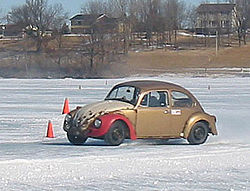Ice Racing
Ice racing, with cars, motorcycles or snowmobiles, takes place on frozen lakes or rivers, or on carefully groomed frozen lots. As cold weather is a requirement for natural ice, it is usually found at higher latitudes in Canada, the northern United States, and in northern Europe.
Motorcycle ice racing
Ice racing usually involves subcategories for full-rubber and studded tires. These classes are applied to cars and motorcycles, although a greater percentage of motorcycles use studded tires. Studs on motorcycles for ice racing are very sharp and may be as long as 75[mm] (2.5 inches) with as many as 500 studs per tire in ice speedway. Historically Czech made 4-stroke Jawa motorcycles have been the dominant force in this sport. Impressive motorcycle ice racing footage can be seen in the Bruce Brown documentary On Any Sunday.
Automobile ice racing
Automobile ice races have been most successful in France, were the Trophée Andros series, sponsored by an industrial jam manufacturer attracts ex-F1 drivers like Alain Prost or Olivier Panis, manufacturer-backed entries of sophisticated 4WD cars and international television coverage. In fact the Trophée Andros races mainly use damped snow (that is not very different from ice regarding car handling) tracks in French ski sations with a final race on artificial ice in Paris Stade de France. The 2006 trophy include one round in Andorra. In several occasions one round was also taking place in Canada. Elsewhere, ice racing has proven to be a largely recreational pastime, as lower mechanical wear rates and engine power requirements lead to lower running costs compared with competing on pavement.
There is a new class called SS (street studs) where a car can run with the same modifications as a rubber to ice class, without the need for a roll bar. [1]
